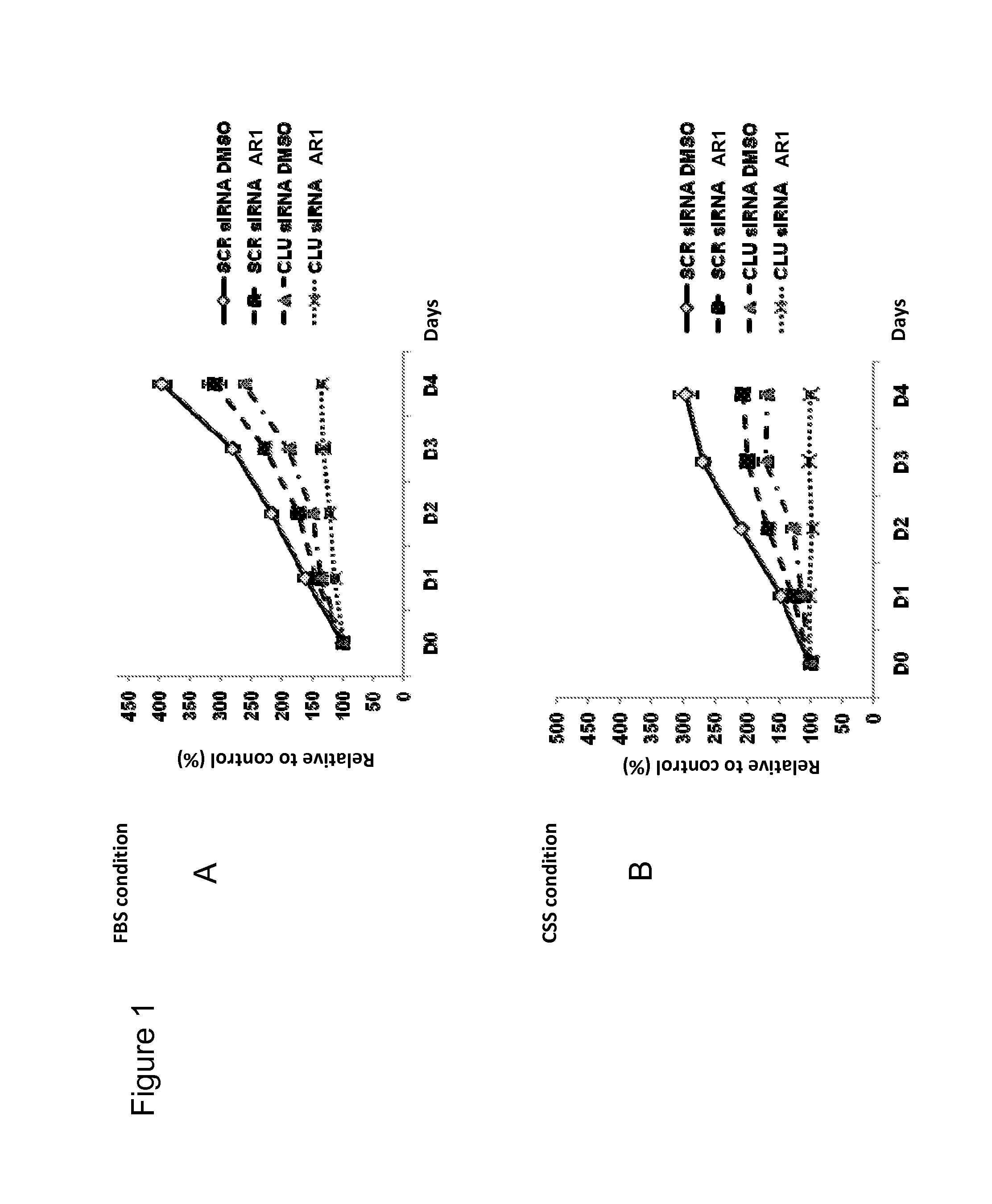Combination of Anti-clusterin oligonucleotide with androgen receptor antagonist for the treatment of prostate cancer
a technology of androgen receptor and anticlusterin, which is applied in the direction of antiparasitic agents, genetic material ingredients, drug compositions, etc., can solve the problems of prostate cancer regression, incomplete apoptosis, and increased tumor size,
- Summary
- Abstract
- Description
- Claims
- Application Information
AI Technical Summary
Benefits of technology
Problems solved by technology
Method used
Image
Examples
example 1
Clusterin Inhibitor Custirsen Together with AR Antagonist AR1 is a Potent Combination Therapy in Castration-Resistant Prostate Cancer Models
Introduction and Objective
[0152]AR and intra-tumoral androgen synthesis are implicated in promoting tumor cell survival and development of castration-resistant prostate cancer (CRPC). AR1, has shown activity in preclinical and clinical studies. Previous studies link androgen ablation therapy with clusterin upregulation and castration resistance. The antisense inhibitor, custirsen, increases cell death when combined with castration or chemotherapy in prostate cancer (CaP) models. Herein below, the ability of custirsen and AR1 combination therapy to delay progression in a castration-resistant LNCaP model was tested.
Methods
[0153]Effects of individual vs combination AR1 and custirsen regimens on AR-positive LNCaP cell proliferation (FIGS. 1-4, and 6-7) and survival (FIG. 5) as well as protein (FIGS. 9, 11, and 13-15), and gene expression (FIGS. 13 a...
example 2
Materials and Methods
Prostate Cancer Cell Lines and Reagents
[0157]LNCaP cells were kindly provided by Dr. Leland W. K. Chung (1992, MDACC, Houston Tx) and tested and authenticated by whole-genome and whole-transcriptome sequencing on Illumina Genome Analyzer IIx platform in July 2009. LNCaP cells were maintained RPMI 1640 (Invitrogen Life Technologies, Inc.) supplemented with 5% fetal bovine serum and 2 mmol / L L-glutamine. Cells were cultured in a humidified 5% CO2 / air atmosphere at 37° C. Cycloheximide and MG-132 were purchased from Calbiochem, R1881 (Perkin-Elmer), AR1 (MDV-3100; Haoyuan Chemexpress Co., Limited). Antibodies: anti-GRP78, anti-CREB2 (ATF4), CLU C-18, AR N-20, AR 441, PSA C-19, Ubiquitin, pERK, β-tubulin and vinculin from Santa Cruz Biotechnology; anti-phospho-eIF2α from Invitrogen Life Technologies; anti-ATF6 from Imgenex Corp; Atg3, LC3, pAkt / Akt, pmTOR / mTOR, pp70S6K / p70S6K, poly(ADP ribose)polymerase (PARP)form from Cell Signaling Technology; and anti-Vinculin an...
example 3
CLU is Highly Expressed in AR1 Resistant Cells and Xenografts
[0168]AR1 is a novel anti-androgen which binds the AR LBD and inhibits the growth of castration-resistant xenografts (Tran et al., 2009). Data from phase II and III trials show that AR1 is active in both pre- and post-chemotherapy-treated patients and decreases levels of PSA and circulating tumor cells (Scher et al., 2010) (Sher, GU-ASCO, 2012). Unfortunately, like first line hormone therapies, CRPC-LNCaP xenografts evolved mechanisms of resistance after the addition of AR1 to castration. CLU was found to be up-regulated in AR1 resistant tumors compared to vehicle treated tumors by western blot (FIG. 41A, left panel) and immunohistochemistry (FIG. 41A right panel, FIG. 30A), suggesting that AR1 treatment induces stress activated molecular chaperone CLU in CRPC tumors similar to that seen with castration in castrate sensitive tumors. To facilitate study of mechanisms of AR1 recurrence, different cell lines were created from...
PUM
| Property | Measurement | Unit |
|---|---|---|
| Time | aaaaa | aaaaa |
| Mass | aaaaa | aaaaa |
| Mass | aaaaa | aaaaa |
Abstract
Description
Claims
Application Information
 Login to View More
Login to View More - R&D
- Intellectual Property
- Life Sciences
- Materials
- Tech Scout
- Unparalleled Data Quality
- Higher Quality Content
- 60% Fewer Hallucinations
Browse by: Latest US Patents, China's latest patents, Technical Efficacy Thesaurus, Application Domain, Technology Topic, Popular Technical Reports.
© 2025 PatSnap. All rights reserved.Legal|Privacy policy|Modern Slavery Act Transparency Statement|Sitemap|About US| Contact US: help@patsnap.com



